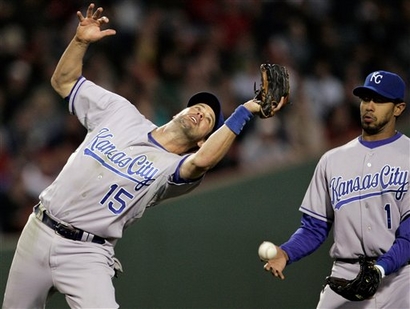* Yankee Stadium hosted its last game last night, with Andy Pettitte picking up the win for the Pinstripes and Mariano Rivera throwing the last pitch. Fans had been allowed to walk on the field before the game, which was a nice touch. Too bad this also marks the first time in 15 years the Yankees will miss the playoffs, but at least that wasn't the game that mathematically eliminated them.
* I was looking through the box scores yesterday and noticed that Arizona 3B Mark Reynolds made his MLB-leading 32nd error of the year, and nobody else is particularly close. Edwin Encarnacion is second with "just" 23. Reynolds also leads the majors in strikeouts with 196, only three short of the all-time record set by Ryan Howard last year, though Howard's right on his tail.
The last time a player led the majors in both errors and whiffs was 1950, when Roy Smalley the elder did it for the Cubs, at the age of 24, like Reynolds. To show you how the game has changed, Smalley never played more than 92 games in a season after that, and I imagine his dubious duo of D'oh! had something to do with that fact. Reynolds, by contrast, leads his team with 28 homers, 60 walks and 94 RBI, so he'll likely be the starter next year as well.
* The Pirates signed their #1 pick, Scott Boras client 3B Pedro Alvarez, ending an extended litigation/negotiation process. He gets $6.4 million instead of $6 million, but the signing bonus is stretched out over 4 years instead of two, so it's nearly a wash with inflation anyway. What's important is that Boras did not wrangle additional millions of dollars out of the Bucs, and did not set a precedent for voiding contracts agreed to by his clients but not himself. Chalk one up for the teams in this one, I think.
* Some of the Houston Astros are lashing out about their so-called "home games" played in Milwaukee (aka "Wrigley North") last week. Hurricaine Ike had forced a lot of people from their homes, and it seemed inappropriate to play baseball down there even if the weather did permit, but did they have to play the Cubs in a venue two hours from their own city? I happened to be in Milwaukee on business and I saw Cubs fans in the airport and heard reports of others around the city. It would be like having the Yankees play the Mariners in Baltimore or Philly and pretending it was a "home game" for Seattle.
Nobody likes a sore loser, of course, but it seems to me that these guys have a legitimate complaint. It could potentially be argued that the Ike-spurred bad weather might have affected Arlington and some of the cities in the midwest, like Kansas City or St. Louis, though it should be noted that there were games played in Cleveland, Pittsburgh and Chicago that Sunday, with no problems from Ike.
But if they wanted a place away form the weather, away from the NFL and a potential drawing problem, and in an area that was at least neutral, if not partial to Houston (as Arlington Texas might have been) they needed to look no further than Atlanta. The Braves were away on Sunday and off on Monday, and the weather was fine. Atlanta's been drawing over 31,000 fans per game this year, so it's not like they would have been trying to get fans who don't normally watch their own team to come and watch a different one (as would have been the case in KC, Tampa or Miami).
And they wouldn't have had to fly all the way to the West Coast and back to play in Los Angeles or San Francisco. Houston had a series in Miami starting Tuesday, so that would have been too long a haul, theoretically. Want to know where the next series was for the Cubs? You guessed it: Milwaukee.
So what this really accomplished was twofold:
1) Minimize the travel expenses for at least one of the teams involved. Check.
B) Make sure there are fans at the game. Check.
There were 23,441 paid tickets for Sunday's game, which turned out to be a no-hitter by Carlos Zambrano, and then another 15,158 on Monday. That's not a stellar turnout, but it's not bad for a previously-unscheduled Monday afternoon game between two non-local teams. Well, one and a half.
A better approach would have been to wait and see if the games were needed until after the season, which ends early this year, on September 28th. But that would have meant that these two teams might not have played, if the games turned out to be meaningless, and all that ticket and ad revenue would have been lost. So maybe ther were three things accomplished in those two days.
Too bad one of them wasn't, "Make sure the Astros are well-served by the solution."



















